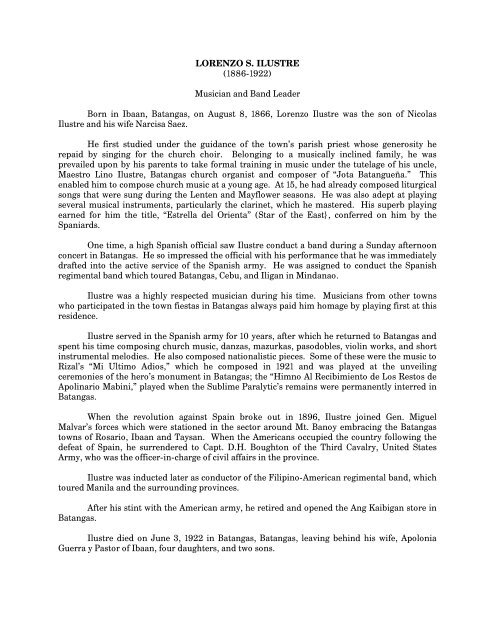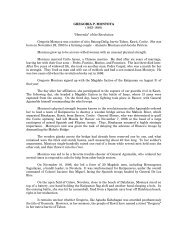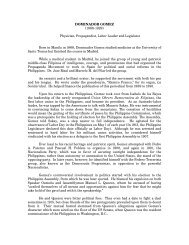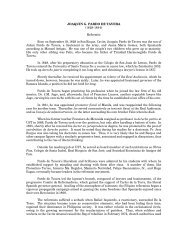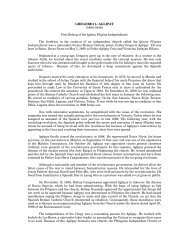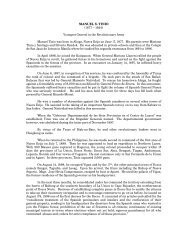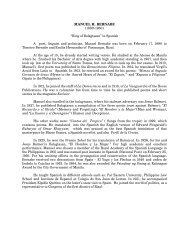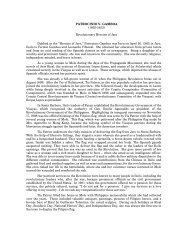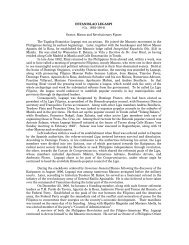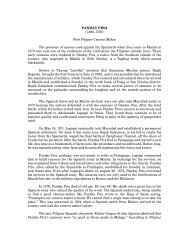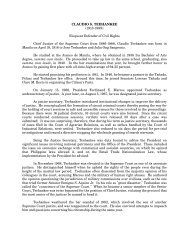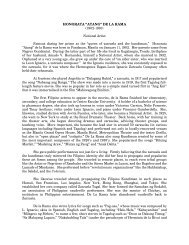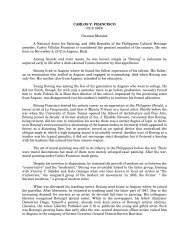LORENZO S. ILUSTRE (1886-1922) Musician and Band Leader ...
LORENZO S. ILUSTRE (1886-1922) Musician and Band Leader ...
LORENZO S. ILUSTRE (1886-1922) Musician and Band Leader ...
You also want an ePaper? Increase the reach of your titles
YUMPU automatically turns print PDFs into web optimized ePapers that Google loves.
<strong>LORENZO</strong> S. <strong>ILUSTRE</strong><br />
(<strong>1886</strong>-<strong>1922</strong>)<br />
<strong>Musician</strong> <strong>and</strong> B<strong>and</strong> <strong>Leader</strong><br />
Born in Ibaan, Batangas, on August 8, 1866, Lorenzo Ilustre was the son of Nicolas<br />
Ilustre <strong>and</strong> his wife Narcisa Saez.<br />
He first studied under the guidance of the town’s parish priest whose generosity he<br />
repaid by singing for the church choir. Belonging to a musically inclined family, he was<br />
prevailed upon by his parents to take formal training in music under the tutelage of his uncle,<br />
Maestro Lino Ilustre, Batangas church organist <strong>and</strong> composer of “Jota Batangueña.” This<br />
enabled him to compose church music at a young age. At 15, he had already composed liturgical<br />
songs that were sung during the Lenten <strong>and</strong> Mayflower seasons. He was also adept at playing<br />
several musical instruments, particularly the clarinet, which he mastered. His superb playing<br />
earned for him the title, “Estrella del Orienta” (Star of the East}, conferred on him by the<br />
Spaniards.<br />
One time, a high Spanish official saw Ilustre conduct a b<strong>and</strong> during a Sunday afternoon<br />
concert in Batangas. He so impressed the official with his performance that he was immediately<br />
drafted into the active service of the Spanish army. He was assigned to conduct the Spanish<br />
regimental b<strong>and</strong> which toured Batangas, Cebu, <strong>and</strong> Iligan in Mindanao.<br />
Ilustre was a highly respected musician during his time. <strong>Musician</strong>s from other towns<br />
who participated in the town fiestas in Batangas always paid him homage by playing first at this<br />
residence.<br />
Ilustre served in the Spanish army for 10 years, after which he returned to Batangas <strong>and</strong><br />
spent his time composing church music, danzas, mazurkas, pasodobles, violin works, <strong>and</strong> short<br />
instrumental melodies. He also composed nationalistic pieces. Some of these were the music to<br />
Rizal’s “Mi Ultimo Adios,” which he composed in 1921 <strong>and</strong> was played at the unveiling<br />
ceremonies of the hero’s monument in Batangas; the “Himno Al Recibimiento de Los Restos de<br />
Apolinario Mabini,” played when the Sublime Paralytic’s remains were permanently interred in<br />
Batangas.<br />
When the revolution against Spain broke out in 1896, Ilustre joined Gen. Miguel<br />
Malvar’s forces which were stationed in the sector around Mt. Banoy embracing the Batangas<br />
towns of Rosario, Ibaan <strong>and</strong> Taysan. When the Americans occupied the country following the<br />
defeat of Spain, he surrendered to Capt. D.H. Boughton of the Third Cavalry, United States<br />
Army, who was the officer-in-charge of civil affairs in the province.<br />
Ilustre was inducted later as conductor of the Filipino-American regimental b<strong>and</strong>, which<br />
toured Manila <strong>and</strong> the surrounding provinces.<br />
After his stint with the American army, he retired <strong>and</strong> opened the Ang Kaibigan store in<br />
Batangas.<br />
Ilustre died on June 3, <strong>1922</strong> in Batangas, Batangas, leaving behind his wife, Apolonia<br />
Guerra y Pastor of Ibaan, four daughters, <strong>and</strong> two sons.
Reference:<br />
CCP Encyclopedia of Philippine Art Volume 6. Manila: Cultural Center of the Philippines,<br />
1994.


